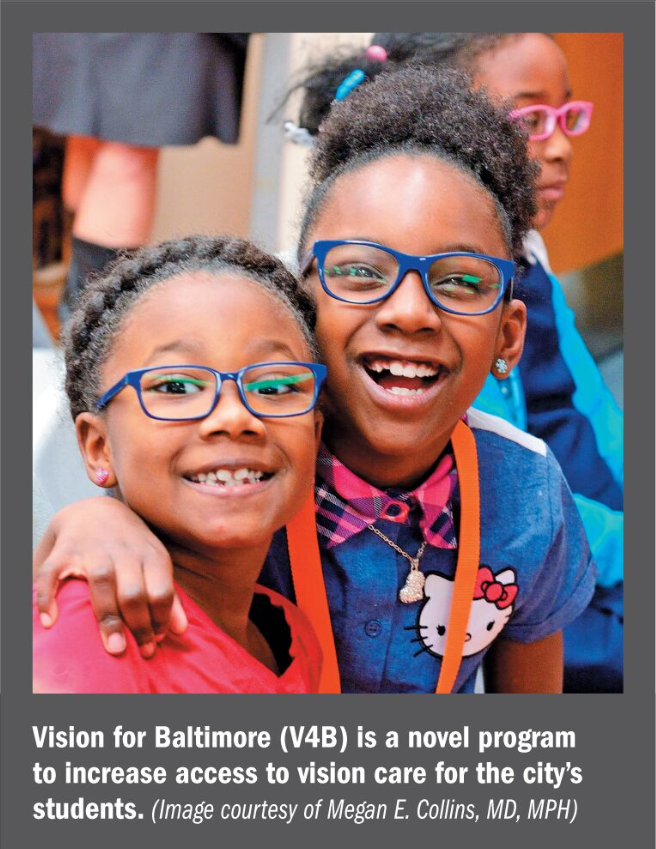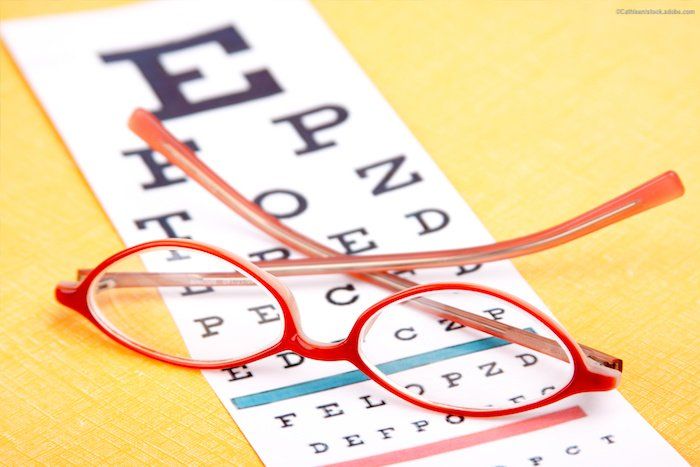Article
School-based V4B program aims to bridge eye-care gap
Author(s):
Disparities exist in delivery of needed vision care for at-risk children, study finds


Lessons from the Baltimore Reading and Eye Disease Study were applied to the creation of Vision for Baltimore.
Reviewed by Megan Collins, MD, MPH
It is important for children with vision problems to have access to eye care. However, there are often disparities in accessing needed care including access to vision screenings and eye exams, and eyeglass wear and retention.
“Many children in need of vision care are not accessing it routinely,” said Megan Collins, MD, MPH, assistant professor of ophthalmology, Wilmer Eye Institute, Johns Hopkins University School of Medicine, Baltimore. “Our work is focused on developing school-based mechanisms to identify children at risk for vision problems and to connect them with the necessary care.”
Failing a vision screening is often the first indication of abnormal vision for elementary and middle school-age children. Though most states mandate vision screening for school-age children, there is no set standard for vision-screening protocols, including which grades receive screening and what elements are included in the screening assessment.
Maryland is one of the states requiring vision screening for school-aged children. Students are first screened when they begin school (either pre-K or kindergarten), and again in first and eighth grade.
School-based care
School-based health programs have been growing over the past decade to provide services such as vision care, asthma management, dental health, and vaccinations within the school setting. The provision of school-based care is one strategy to advance healthcare access and equity.1
Dr. Collins and other researchers from the Wilmer Eye Institute and Johns Hopkins School of Education led the Baltimore Reading and Eye Disease Study (BREDS), a school-based research program to study the impact of eyeglasses on reading achievement. It was conducted in 12 Baltimore City Public Schools during the 2014–15 and 2015–16 school years.
Second- and third-grade students were given vision and reading assessments at baseline, one year, and two years. Though BREDS was a research study, it found that a substantial number of Baltimore students were not accessing eye care.
Vision for Baltimore
Lessons learned from the BREDS were applied to the creation of Vision for Baltimore (V4B), a novel citywide program to increase access to vision care for the city’s students. V4B, which launched in fall 2016, is a collaborative effort with the Baltimore City Health Department, Johns Hopkins’ Wilmer Eye Institute and the School of Education, Baltimore City Public Schools, Vision To Learn, and Warby Parker.
The program was designed to provide vision-care services for the approximately 62,000 elementary and middle-school students in the city of Baltimore. It covers all 152 schools in the Baltimore City Public Schools system, reaching 50 schools each year, so that all students are served over a three-year period.
The program includes vision screenings for every student in grade preK-8 (an expansion from the state mandate), and a mobile vision clinic at each school. Eyeglasses can be prescribed, dispensed, and replaced as needed.
Long-term monitoring of the use of eyeglasses is also being performed. Built in to the program from the start was an objective to study this delivery system and outcomes. The screenings are performed by Baltimore City Health Department vision-screening teams. Any students who fail a vision screening are offered an eye exam at school.
The eye exams are conducted by Vision To Learn optometrists, and include distance visual acuity, cover testing, auto-refraction, manifest refraction, and near acuity (based on symptoms).
Dr. Collins and collaborators at Johns Hopkins’ Wilmer Eye Institute and the School of Education are conducting a study, using data collected in the V4B project, to determine the prevalence and severity of refractive error diagnosed among students.
The study is also evaluating the impact of school-based eye care on academic performance and developing school-based strategies to promote eyeglasses wear and to reduce the rate of lost or broken glasses.
Disclosures:
Megan E. Collins, MD, MPH
E: mcolli36@jhmi.edu
This article was adapted from Dr. Collins’ presentation at the 2018 meeting of the Johns Hopkins Wilmer Eye Institute’s Current Concepts in Ophthalmology in Baltimore. Dr. Collins has no financial interests or relationships to disclose.
References:
1. Basch CE. “Healthier students are better learners: high-quality, strategically planned, and effectively coordinated school health programs must be a fundamental mission of schools to help close the achievement gap.” J Sch Health. 2011;81:650-662.
Newsletter
Don’t miss out—get Ophthalmology Times updates on the latest clinical advancements and expert interviews, straight to your inbox.




